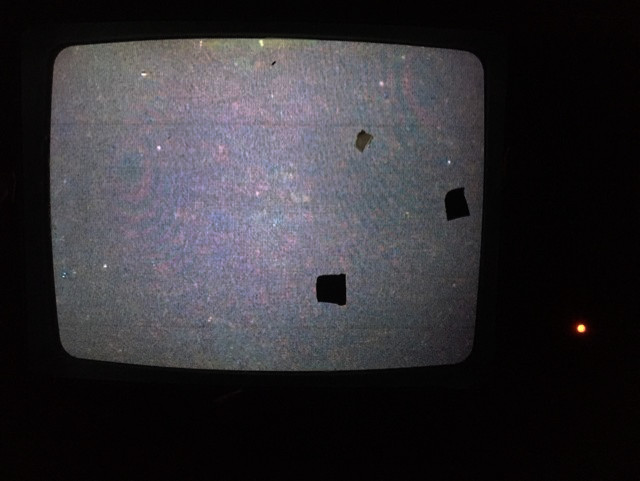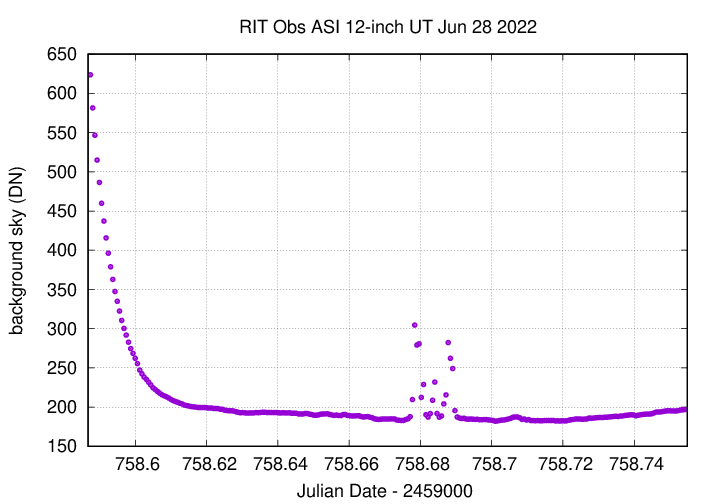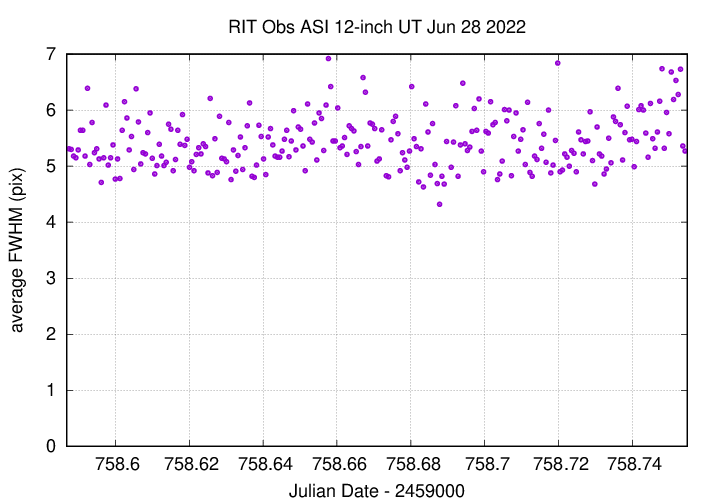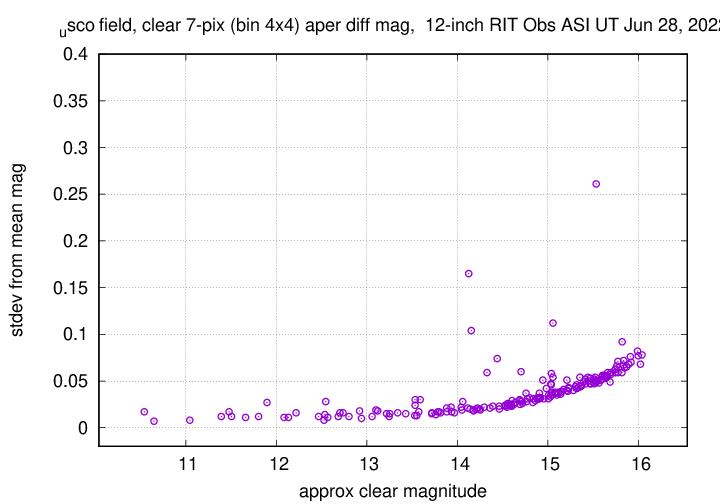
On the night of Jun 27/28, 2022, under good conditions, I acquired images of the outbursting cataclysmic variable star U Sco.
Tonight's observations were made on the 12-inch telescope, as usual, but with the new ASI camera. I'm going to use this setup for future U Sco measurements, as it yields slightly better measurements than the ATIK camera. I also increased exposure time to 45 seconds.
During the night, I used the ATIK camera on the 14-inch telescope in the rolloff structure to adjust the polar alignment of that mount. It seems to have helped; I'll show a few sample exposures of M57 to illustrate.
U Sco is a cataclysmic variable which only rarely is caught in an outburst. This one was first noticed at UT 2022 June 6.720 by Masayuki Moriyama. The star reached a peak brightness of about V = 8, but faded quite a bit by this evening; it is currently about V = 14.4.
The main setup was:
Notes from the night:
The object is located at
RA = 16:22:30.78 Dec = -17:52:42.8 (J2000)
A chart of the field is shown below. The size of the chart is about 42 x 30 arcminutes.

I've marked the location of several comparison stars as well, which appear on the AAVSO chart of comparison stars.
I'll use star "A" to shift my instrumental magnitudes to the V-band scale.
I took a photo of the finder TV's screen when pointing to this target; this could be a useful reference for the future:

The sky value shows a short period clouds in the middle.

The FWHM graph below shows a small rise as the temperature dropped. I didn't refocus.

Using aperture photometry with a radius of 7 pixels in clear filter (binned 4x4, each pixel is 1.052 arcsec, so a radius of 7.4 arcsec), I measured the instrumental magnitudes of a number of reference stars and the target. Following the procedures outlined by Kent Honeycutt's article on inhomogeneous ensemble photometry, I used all stars available in each image to define a reference frame, and measured each star against this frame.
Sigma-vs-mag plots show that the floor was about 0.008 mag.

The change in zeropoint shows the effects of high airmass near the end; the many outliers are due to poor tracking (45-second exposures are near the limit for this mount).

The measurements show a big increase in brightness, and very low scatter: about 0.02-0.03 mag.

You can download my measurements below. A copy of the header of the file is shown to explain the format.
# Measurements of U_Sco made at RIT Obs, UT 2022 Jun 28, # in good conditions, # by Michael Richmond, # using Meade 12-inch LX200 and ASI 6200MM. # Exposures 45 seconds long, clear filter. # Tabulated times are midexposure (FITS header time - half exposure length) # and accurate only to +/- 1 second (??). # 'mag' is a differential magnitude based on ensemble photometry # using a circular aperture of radius 7 pix = 7.4 arcseconds. # which has been shifted so AAVSO 000-BBX-431 has mag=10.707 # which is its V-band magnitude according to AAVSO. # # UT_day JD HJD mag uncert Jun28.08741 2459758.58741 2459758.59252 14.527 0.025 Jun28.08803 2459758.58803 2459758.59314 14.510 0.031 Jun28.08867 2459758.58867 2459758.59378 14.508 0.032
I placed the ATIK 11000 camera with filterwheel onto the 14-inch telescope in order to take a set of images to check the polar alignment; data taken over the past few nights on this telescope showed that stars would slowly drift in the field over periods of ten to twenty minutes, indicating that the polar alignment wasn't great.
Following the drift method, described in many places such as
I first pointed to a star near the celestial equator and the meridian. I measured the drift over 15 minutes, then adjusted the azimuth setting of the mount (loosen 4 az knobs, then tighten left screw, loosen right screw). A second measurement over 17 minutes showed I'd slightly moved too far, so I moved back slightly. A third measurement showed a drift of only 1 pixel over 18 minutes, which was good enough for me.
I then moved the telescope to a star near the celestial equator and western horizon. A cloudbank slowed me down, but eventually the sky cleared. Several measurements showed motions of just 2 pixels north, then 4 pixels south, over 15 and 13 minutes, respectively. These seemed small enough (and in opposite directions) that I decided to make no adjustment to the altitude position of the mount.
Having finished my adjustments, I took a series of images of M57 with increasing exposure times: 5, 30, 120 and 300 seconds. A closeup of the field (rotated by 180 degrees, so North down, East to right) from one image at each exposure time is shown below.

There is no large, obvious trailing visible to the eye, even in the 300-second exposure. It is a bit suspicious that the faintest stars visible to the eye (about G = 17) don't change between 120 and 300 seconds. A match between the positions of detected stars and the Gaia EDR3 catalog showed a small increase in the residuals: the standard deviation grew by about 80 percent as the exposure time increased from 30 seconds to 300 seconds.
Still, I think it will be possible to take unguided images with exposure times of 100 or even 200 seconds for photometric purposes.
Also, for reference, here's a table showing the plate scale of each camera (with filterwheel) on each telescope. The units are "arcseconds per pixel".
Camera 12-inch Meade 14-inch Celestron
------------------------------------------------------------------------
ATIK 1.254 (V)
1.257 (clear) 0.934 (clear)
ASI 1.052 (clear) 0.792 (clear)
------------------------------------------------------------------------
I derive focal lengths of 2960 or 2949 mm for the 12-inch (ATIK or ASI), and 3975 or 3917 mm for the 14-inch (ATIK or ASI). These correspond to effective focal ratios of about f/9.7 for the 12-inch and f/11.1 for the 14-inch.
Last modified 6/28/2022 by MWR.